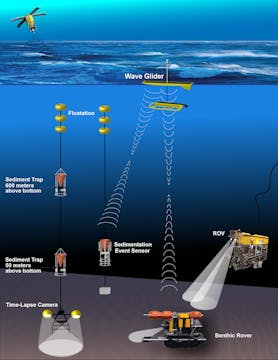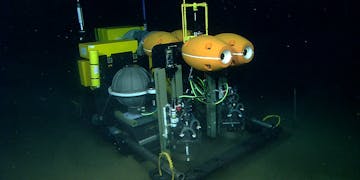The deep seafloor is one of the largest and least known habitats on this planet. The flat, muddy, wide-open stretches of the deep ocean floor—known as the abyssal plain—cover more than 50 percent of Earth’s surface and play a critical role in the carbon cycle. Scientists visit from time to time, but they rarely get to stay long. That’s one reason why the work of MBARI Senior Scientist Ken Smith is so remarkable. For 30 years, Smith and his colleagues have studied deep-sea communities at a research site called Station M, located 4,000 meters (2.5 miles) below the ocean’s surface and 291 kilometers (181 miles) off the coast of Santa Barbara, California. The results of this research have dramatically changed marine biologists’ perceptions of life in the deep sea and our understanding of climate change.
Amazing as it may sound, organisms on the deep seafloor get most of their food from the sunlit surface waters thousands of meters above, where the story of the marine carbon cycle begins. This food, also known as particulate organic carbon, typically arrives in the form of marine snow—bits and pieces of dead algae or animals that sink to the muddy ocean bottom. This detritus carries carbon from the surface waters to the deep sea. Because much of this carbon originated as carbon dioxide in the atmosphere, sinking marine snow indirectly reduces greenhouse gas concentrations, sequestering organic carbon in the deep ocean over geological timescales.
Smith wanted to study how large fluctuations in marine snow affect life on the deep seafloor. He chose the site of Station M based on early satellite color images, which frequently showed plumes of chlorophyll (microscopic algae) being carried offshore from Point Conception. These plumes frequently pass over Station M during seasonal blooms of algae on the surface. Smith wondered how these blooms would translate to changes in marine snow and in deep-sea communities that rely on it for food.
Smith started work at Station M in 1989 to determine how deep-sea communities respond to changes in food supply produced at the ocean's surface. One of his team’s biggest challenges has been figuring out the best methods to measure the food supply and the responses of deep-sea communities over long periods of time.

This illustration shows some of the different types of instruments that MBARI researchers use to study life on the seafloor at Station M, as well as the food supply and food consumption of deep-sea animals and microbes. In addition to underwater instruments, the researchers also use satellite imagery to estimate the concentration of chlorophyll from algae living at the sea surface. When these algae die, they supply food for animals on the deep seafloor. Illustration by Shannon Boedecker.
Over the past three decades, Smith and his colleagues have developed and used a whole suite of oceanographic tools to study Station M. These include satellites, research ships, bottom trawls, human-occupied vehicles such as Alvin, remotely operated vehicles (ROVs), a seafloor Rover, seafloor landers, coring devices, fish traps, sediment traps, respirometers (which measure oxygen consumption), current meters, and time-lapse cameras. Ultimately, Smith and his team built an underwater observatory that operates 24 hours a day, seven days a week, for a full year without servicing.

Some of these seafloor instruments and robots can collect data on hourly or daily time scales, creating a unique 30-year record of conditions at Station M. In fact, Station M is the only deep-sea site in the world where scientists have such long-term, continuous measurements of the supply of carbon to the seafloor and the consumption of this organic carbon by deep-sea animals and microbes.
Smith’s early work at Station M was carried out while he was at Scripps Institution of Oceanography, and was supported by the National Science Foundation. In 2006, Smith moved his lab to MBARI. Since then, MBARI has provided ship time, ROV dives, and funding for new instruments, including a seafloor robot called the Benthic Rover. These days, undersea robots and automated instruments collect most of the data at Station M, with scientists and engineers traveling out to service the equipment annually.
The long-term data from Station M has changed how oceanographers view life and the physical conditions on the deep seafloor. For one thing, the data show that the deep sea is far from static—physical conditions and biological communities can change dramatically over time scales ranging from days to decades.
The research at Station M confirmed that these changes at the seafloor directly relate to conditions near the sea surface, especially in response to large population blooms of algae or gelatinous animals such as salps. After consuming available nutrients and food in surface waters, reproducing quickly and in large numbers for a week or so, salps can then die en masse, sinking rapidly to the bottom.
The resulting “blizzard” of food provides a feast for deep-seafloor organisms, allowing some species to reproduce and dominate seafloor communities—at least until most of the food is used up. For example, throughout the 30-years of observations, some species of sea cucumbers started out as rare, then became extremely abundant, and then disappeared entirely. Other sea cucumbers had relatively stable populations throughout the 30-year study.

The researchers were surprised to find that the amount of organic detritus reaching the seafloor increased dramatically most recently between 2011 and 2018. At the same time, Smith’s instruments showed that animals and microbes in the sediment were consuming much more oxygen than during previous years. (How much oxygen organisms use is directly related to how much food they consume.)
Smith’s research also shows the direct connection between climate change and the deep ocean. The episodic pulses of organic carbon exported from surface waters are monitored by the sediment traps and time-lapse cameras, and are measured as pulses of food to the seafloor. If these pulses are not accounted for, carbon flux—the energy fueling abyssal life—is underestimated in climate models by about 50 percent. Additionally, the amount of oxygen in the water near the seafloor at Station M was about seven percent lower during the last 15 years of the study than it was during the early years. This parallels a decline in the concentration of oxygen in the surface water of the California Current, which flows over Station M.
The scientists are still working to understand exactly what happens to food particles as they sink from the surface down to the deep sea. They know that particles, especially those that sink slowly, are often eaten and excreted several times before they reach the seafloor, as well as being consumed and transformed by marine microbes. According to Smith, these processes constitute a “missing link” in tracking carbon from the surface to the ocean bottom.
To commemorate the 30-year time series at Station M, researchers from around the world have written 16 papers to be published this summer (2020) in a special issue of Deep-Sea Research. These papers cover a wide range of topics, from satellite observations of the sea surface to the behavior and genetics of deep-sea life.
Long-term studies such as Smith’s Station M time series are essential for understanding long-term changes in the ocean and in Earth’s climate. Smith and his research team hope to continue their work at Station M to find out if the surprising increase in organic detritus over the past decade will continue. They will also be developing new technologies that will allow researchers to monitor conditions at Station M from shore in real-time.
All of this work will benefit from Smith’s continuing collaboration with MBARI’s engineers and marine operations staff. The results of the work are likely to further revise our perceptions of life on the deep seafloor, and more accurately predict the marine carbon cycle through changing climate conditions.
